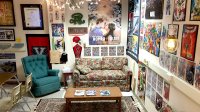High School Flexible Seating Done Right
Interested in switching to flexible seating? Get funding ideas, helpful tips, and how-to photos from the pros—your fellow high school teachers.
Teacher Stephanie Sleeper was intrigued by a photo of a flexible high school classroom, but she needed to know more. “Can I ask how many students you have in an average class?" she asked Emily Polak, who took the picture. “I so want to do this with my high school social studies classroom, but I’m worried about space.”
Sleeper wasn't the only one feeling anxious. The sheer size of high school students is a concern for teachers who are exploring the leap to flexible seating in grades nine through twelve. Without the efficiency of rows of desks, how do you squeeze a lot of big kids into learning spaces that are often no larger than 700 square feet?
And the questions didn’t stop there when we asked high school educators for their thoughts on flexible seating. They also wanted to know if flexible seating would make things too casual, producing a climate of distraction—or even outright chaos. A few educators worried that there might be more students sleeping in class, or using the new space to socialize with friends instead of learning. Other teachers, already spending too much of their own money on classroom upgrades, expressed doubt about finding the money to fund purchases of new furniture.
The good news? In our recent email interviews with 20 teachers who have converted to flexible seating—five of whom were high school teachers—we found positive responses to most of the common issues. High school teachers were making flexible seating work in rooms that averaged about 750 square feet. The number of students per class ranged from 27 to 34. Respondents were almost universal in reporting that their students took their seating options seriously and that discipline problems had actually decreased since the shift to flexible seating.
There were some challenges. Furniture breaks more easily with bigger bodies, a few teachers noted. Funding often came up short of ambitions, leaving teachers to source tables, couches, and chairs from friends and family, thrift stores and garage sales, PTA grants, and crowdfunding campaigns on sites like DonorsChoose. Standardized testing forced some of the teachers to bring desks back into the room at intervals.
But none of the teachers expressed regret. Almost all of our interview subjects—across all 20 classrooms, from kindergarten through high school—loved their new setups. Some of them had started small and then evolved their classrooms gradually. A few had come to flexible seating after many years in traditional spaces. “I am in my 13th year of teaching, but this is my first year to incorporate flexible seating into my classroom,” said first-grade teacher Ashley Rice Broomfield, before expressing a common sentiment: “I will never go back to traditional seating.”
Here’s a look into the classrooms of four high school teachers who we reached out to.
Emily Polak
Classes: English 9 and Freshman Composition
School: Bob Jones High School, Madison, Alabama
Students/Room Dimensions: 27–31 students; room is 780 square feet, about 30 feet by 26 feet
Setting It Up: My goal for this project was to make students feel at home in my classroom. I had a very small budget, so I relied heavily on donations and bargain hunting at thrift stores. The PTSA at our school provided me with a grant of $200, which allowed me to purchase a couch, a love seat, a rug, two small tables, and about eight folding chairs. A friend donated a coffee table, while a parent donated a second area rug. I added my own soft lighting, additional bookshelves, and Harry Potter decorations to make the room feel additionally cozy. Some of my students actually prefer to sit in desks, which surprised me, while others tuck themselves away in the Harry Potter reading nook.
Benefits: Discipline issues have significantly decreased. My students seem to feel more relaxed and more motivated in a setting that honors their choices. I have not had to assign seats for the majority of the semester because my students know that if they cannot get their work done on the “fun seats,” they will be moved to a desk. I make sure to explain to them that this isn’t a punishment; I am here to help them be successful, and sometimes that means making hard choices.
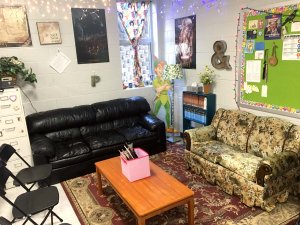
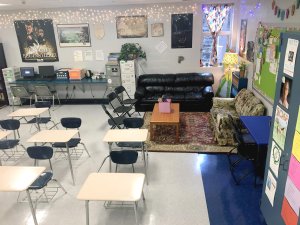
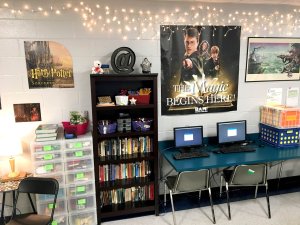
Josh McDaniel
Class: 11th-Grade English
School: Ronald Reagan High School, San Antonio, Texas
Students/Room Dimensions: 30 students; room is 780 square feet, about 30 feet by 26 feet
Setting It Up: I used hanging lights, Christmas lights, and Edison lights to give the room an atmosphere of relaxation. I added a recliner, love seat, and sofa—and even a disco ball to the ceiling and black lights around the Smart Board for special days and assignments. I installed a charging station for phones and brought in a mini-fridge and microwave. Students have a stake in the comfort because they donate coffee and tea for the Keurig. Each grouping of desks has its own supply tub for the week: scissors, glue sticks, note cards, and sticky paper. There’s even an official class pet called Bruce the Beta Fish. I let the students see my personality a bit through the inclusion of family pictures and a wall of college and sports memorabilia.
Benefits: The students have responded with better attendance and written work, improved grades, and a more positive culture in the room. If students are worried about their phones, their stomachs, or being tired, they can’t pay attention and focus in class. Now I have removed those issues from the equation.
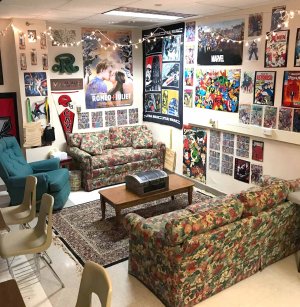
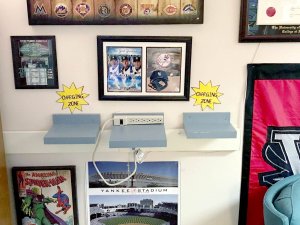
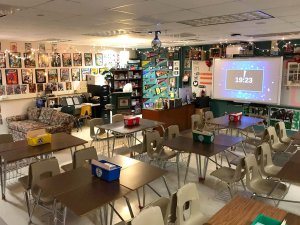
Kendra Caralis
Classes: 9th-Grade World History
School: Grosse Pointe South High School, Grosse Pointe, Michigan
Students/Room Dimensions: 30–32 students; room is 750 square feet, about 30 feet by 25 feet
Setting It Up: A major hurdle was making sure the school could still use my room for state testing, so twice a year the students help me move the desks back into the room. We pile all the furniture up in the front of the room to make space. I funded some furniture purchases through a DonorsChoose campaign, and I did a fair amount of garage sale shopping over the summer. Some was old furniture I owned, and a few pieces were donated from families in the classroom. I don’t implement a seating chart. During the first week, I make students choose a new seat each day so they get a chance to try out different spots—and they are aware that I reserve the right to move them at any point.
Benefits: Most of the examples I’ve seen were for little kids with little bodies, so it wasn’t easy to make the adjustments for high schoolers. Students tell me they can focus better in my room because they aren’t uncomfortable, and I have not had any issues of kids falling asleep. I think there are probably fewer kids falling asleep this year than in previous years, when I just had desks.
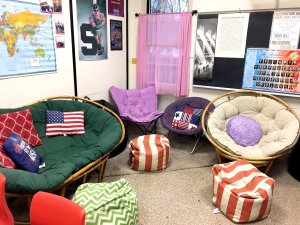
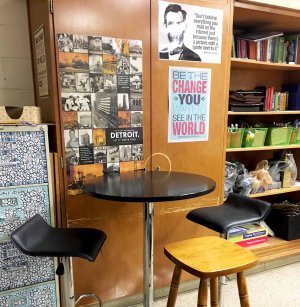

Nichole Murray
Classes: Spanish 3 and 4
School: Marina High School, Huntington Beach, California
Students/Room Dimensions: 25–37 students; room is 784 square feet, about 28 feet by 28 feet
Setting It Up: I changed seating formats during the year. For the first four months of the 2016–17 school year, my 153 Spanish 3 and Spanish 4 students had a traditional seating classroom. They all sat in student desks facing forward or moved the desks into group configurations. After that the same students had a flexible seating classroom with a layout that included a wide variety of furniture types. We have four standing desks, two cocktail tables with stools, two armchairs with ottomans, a sofa, four gaming chairs, and two beanbag chairs. For the first two weeks of the new seating, students had to try a different seat every day to experience each of the 10 “zones.” After that students could choose where they wanted to sit on a first-come, first-served basis.
Benefits: I conducted a survey (there were 143 participants) to test the results of the new flexible seating model. Here’s the basic summary: Students transitioned to the new seating style easily, strongly favored the change, and made their daily seating selection with a desire for success in mind. Students were less sure that they were “retaining information better” than that they “were not distracted,” but the overall results were very encouraging.
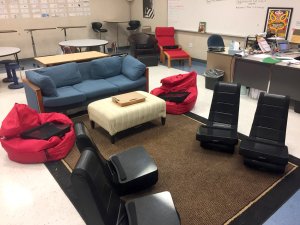
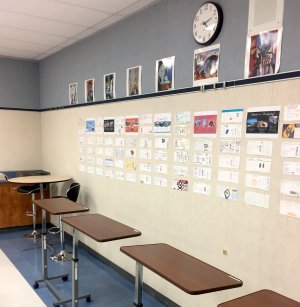
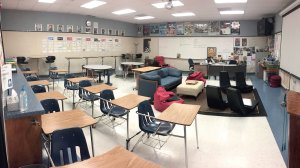
This article would not have been possible without the contributions and/or photography of the following educators: Kendra Caralis, Josh McDaniel, Nichole Murray, Emily Polak, and Mylène St-Cyr. Their classrooms are amazing, and we’re grateful they shared them with us.
